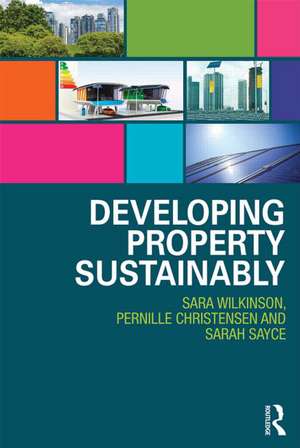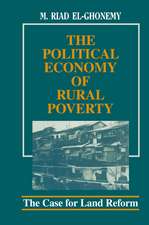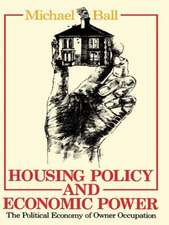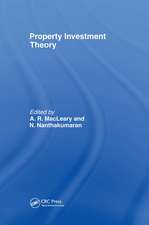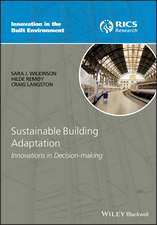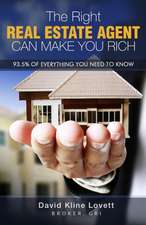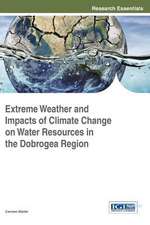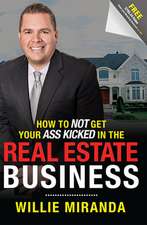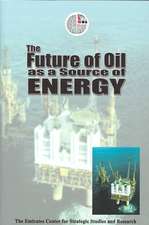Developing Property Sustainably
Autor Sara Wilkinson, Sarah Sayce, Pernille Christensenen Limba Engleză Paperback – 17 iun 2015
Starting by exploring key definitions and stakeholders, the book goes on to explore finance, planning, construction, procurement, occupation, retrofit and lifecycle sustainability in order to provide the reader with a detailed understanding of all the issues involved in the delivery of sustainable property development from inception to occupation and beyond.
Throughout the book, international case studies are used to demonstrate how sustainable property development is applied in practice around the world. With a logical chapter structure and accessible writing style, Developing Property Sustainably would be perfect for use on undergraduate and postgraduate modules and courses in real estate development, property and urban development and other built environment programmes.
| Toate formatele și edițiile | Preț | Express |
|---|---|---|
| Paperback (1) | 475.62 lei 6-8 săpt. | |
| CRC Press – 17 iun 2015 | 475.62 lei 6-8 săpt. | |
| Hardback (1) | 1390.16 lei 6-8 săpt. | |
| CRC Press – 22 iun 2015 | 1390.16 lei 6-8 săpt. |
Preț: 475.62 lei
Preț vechi: 559.55 lei
-15% Nou
Puncte Express: 713
Preț estimativ în valută:
91.01€ • 95.70$ • 75.20£
91.01€ • 95.70$ • 75.20£
Carte tipărită la comandă
Livrare economică 17 aprilie-01 mai
Preluare comenzi: 021 569.72.76
Specificații
ISBN-13: 9780415835671
ISBN-10: 0415835674
Pagini: 312
Ilustrații: 1 black & white illustrations, 18 black & white tables, 6 black & white halftones, 27 black & white line drawings
Dimensiuni: 174 x 246 x 18 mm
Greutate: 0.54 kg
Ediția:1
Editura: CRC Press
Colecția Routledge
ISBN-10: 0415835674
Pagini: 312
Ilustrații: 1 black & white illustrations, 18 black & white tables, 6 black & white halftones, 27 black & white line drawings
Dimensiuni: 174 x 246 x 18 mm
Greutate: 0.54 kg
Ediția:1
Editura: CRC Press
Colecția Routledge
Public țintă
Postgraduate, Professional, and UndergraduateCuprins
Foreword Paul Edwards 1. Introduction to Sustainable Property Development Sara J. Wilkinson and Sarah L. Sayce 2. Stakeholders through the Development Process Sara J. Wilkinson and Sarah L. Sayce 3. Site Feasibility Sara J. Wilkinson and Sarah L. Sayce 4. Project Appraisal and the Triple Bottom Line Sarah L. Sayce 5. Financing the Project – Economic Incentives Promoting Sustainable Property Development Chris Eves 6. Planning and Regulatory Issues Impacting Sustainable Property Development Pernille H. Christensen and Sarah L. Sayce 7. Sustainable Construction Issues Sara J. Wilkinson, 8. Procuring the Project in a Sustainable Way Sara J. Wilkinson and Sarah L. Sayce 9. Sustainable Property Reporting and Rating Tools Pernille H. Christensen and Sarah L. Sayce 10. Post Occupancy Evaluation and Building Operation Issues Sara J. Wilkinson and Sarah L. Sayce 11. New Build Versus Adaptation Sara J. Wilkinson Postscript Sara J. Wilkinson and Sarah L. Sayce
Notă biografică
Sara J. Wilkinson is Associate Professor at the University of Technology Sydney, Australia and a Fellow of RICS. She is widely published in the areas of sustainability, building adaptation and property.
Sarah L. Sayce is Emeritus Professor at Kingston University, UK, having previously led the School of Surveying and Planning there for many years. She holds both an initial degree and PhD from the University of Reading and is a Chartered Surveyor. In addition to being a well-known academic, author and researcher in the field of sustainability and real estate, she is active in her professional body, for which she is currently an elected member of the International Governing Council.
Pernille H. Christensen is a Senior Lecturer at University of Technology, Sydney, Australia where she is the Course Director of the Property Economics programme. Her research focuses on decision making related to sustainability in the built environment.
Sarah L. Sayce is Emeritus Professor at Kingston University, UK, having previously led the School of Surveying and Planning there for many years. She holds both an initial degree and PhD from the University of Reading and is a Chartered Surveyor. In addition to being a well-known academic, author and researcher in the field of sustainability and real estate, she is active in her professional body, for which she is currently an elected member of the International Governing Council.
Pernille H. Christensen is a Senior Lecturer at University of Technology, Sydney, Australia where she is the Course Director of the Property Economics programme. Her research focuses on decision making related to sustainability in the built environment.
Recenzii
This book sets out the key elements of how to develop property sustainably, from the pragmatic perspective that sustainability is a contested and relative concept. Drawing on international case studies, the book offers an excellent insight into how sustainability can be embedded in the lifecycle of property development from feasibility through appraisal and construction, financing, procurement and subsequent, in use operations. Written in accessible and punchy style, the book also offers a critical insight into the plethora of rating and assessment tools for buildings. The authors are well-recognised experts in their field and this book will appeal to a wide range of readers from students through to practitioners.
Professor Tim Dixon, Chair in Sustainable Futures in the Built Environment, University of Reading
Professor Tim Dixon, Chair in Sustainable Futures in the Built Environment, University of Reading
Descriere
Developing Property Sustainably provides a clear and practical overview of the key issues surrounding the sustainable property development process, providing a critical appraisal of the problems faced by global built environment stakeholders. Despite the continued research and debate on sustainable practices, the property development industry is failing to adequately respond and adopt more rigorous measurement techniques and sustainable approaches. Drawing on both practice and academia, the book provides an overview of sustainable property development from inception to occupation and beyond and will be useful to students of real estate development, property and urban development.
